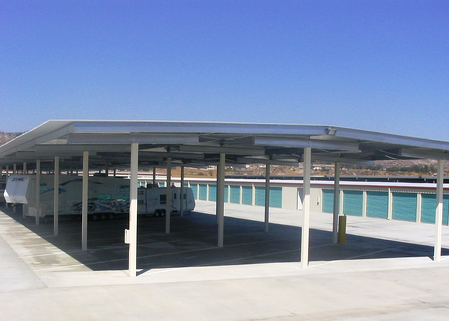
Market Demand is Stronger Than Ever for RV Storage
RV ownership in the U.S. hits new highs! The number of RV-owning households grew to 8.9 million in 2011, up from 7.9 million in 2005. A whopping 8.5% of U.S. households now own an RV. This is good news for the self-storage business.
Most communities have restrictions regarding parking for boats and RVs on the street or driveways. This provides an excellent opportunity for self-storage businesses to meet the resulting demand. If you are looking for ways to bring new revenue to your self-storage business, look no further than RV storage buildings.
Smart self storage operators not only provide storage for these massive vehicles but a host of complementary services.

Before you can reap the rewards of RV storage, you’ll need to decide on the type of storage you will offer and the services you will provide. Following are considerations for a smooth ride into RV storage.
RV Storage Construction
The economics of the local area are a significant factor in deciding the type of RV storage and services you should offer. Boat and RV storage can be as basic as larger than normal, outdoor parking spaces. But most of today’s RV enthusiasts want to protect their investment with covered structures and often demand a host of ancillary services.
Keep in mind that in addition to the recreational vehicle, many customers want extra space to accommodate add-on fixtures, such as motorcycle racks, tow bars, air-conditioning units, etc. They also may want to store other expensive toys that they use when they go on their RV adventures such as jet skis, snow-mobiles and more. While some RV storage customers will be willing to rent another unit for these items, many will only rent RV storage that can meet all their storage needs in a single unit.
Typically, the minimum unit width is 12 feet with a maximum depth of 45 to 50 feet. The most common unit size is 14 feet wide with mixed depths up to 40 feet and an eve height of about 16 feet. When determining the best size, consider the cost to build vs. potential income on a per-square-foot basis.
For example, a 14' by 40' unit consumes 560 square feet of land. You could use that land for several traditional storage units, so you will want to gage market demand to determine if RV storage buildings will be more profitable for your self-storage business than basic mini-storage buildings.
Often Overlooked Costs
When it comes to weighing costs, many self-storage business owners forget to consider whether their storage canopies or three-sided RV Storage Units are considered “buildings” by their local tax authority. This will have a significant impact on the tax assessment.
 Fire sprinklers, which increase construction costs and ongoing operational expenses, are another overlooked outlay. In some areas, even canopies of more than a certain size require sprinklers.
Fire sprinklers, which increase construction costs and ongoing operational expenses, are another overlooked outlay. In some areas, even canopies of more than a certain size require sprinklers.
The additional structural strength required by these oversized units increases the cost of building components. The total price of RV storage usually ends up slightly higher than that of traditional self-storage but significantly less than climate-controlled storage.
A traditional mini storage structure is built on a 5-by-10-foot grid with 4-inch, 16-gauge Cee studs, girts and Zee purlins. (Cees are vertical supports, Girts are horizontal supports, and Zees are the roof members.) To expand the building to greater heights or widths needed for RVs while maintaining structural strength, the builder must use more Cees, girts and Zees, or stronger members (6- to 8-inch and 14-gauge). Additional strength can also be obtained by building with clear span or rigid-frame buildings.
Adding height to a building also increases the need for greater wind resistance. In canopy units, the roof will catch the wind like a kite and must be appropriately anchored. The more walls the structure has, the less uplift there is against the roof. The amount of reinforcement required depends on the height and width of the building and wind-load regulations for the area. These factors are normally determined by your structural engineer or metal-building provider. MakoRabco offers FREE engineering and design services and will gladly help you determine the requirements for your RV storage project.
For enclosed units, doors must also meet higher wind-load requirements. Roll-up doors larger than 14-by-14 feet tend to catch wind deflection that they could jump their tracks. Any door larger than 100 square feet should have a chain hoist or other door-opening mechanism.
For more information about RV Storage Building Design Considerations, click here.
Drive Aisle Requirements
Other construction considerations are the drive aisles and turning radiuses necessary to accommodate large vehicles. “Pull-though access” is often promoted in advertising for boat and RV storage because operators recognize the value of easy maneuverability.  Backing into a unit in tight quarters is an invitation for disaster. Drive aisles for open-air storage should be 50 to 60 feet wide for perpendicular spaces and at least 35 feet wide for spaces angled at 60 degrees.
Backing into a unit in tight quarters is an invitation for disaster. Drive aisles for open-air storage should be 50 to 60 feet wide for perpendicular spaces and at least 35 feet wide for spaces angled at 60 degrees.
Security
RVs and boats can cost anywhere from $500 to well over a million dollars so security is paramount. At a minimum, you’ll need perimeter fencing, which can consist of anything from chain link and razor wire to solid block walls.
As 24-hour access is often a requirement of this type of storage, camera surveillance and key-coded entry gates are often employed. Ingress and egress keypads should be positioned at 42 and 66 inches from the ground to accommodate the window heights of cars and RVs. It’s wise to have a camera aimed at vehicle license plates as they enter and exit the facility. You can also use proximity card readers, adding limited-access zones for only those tenants with stored vehicles.
More sophisticated security measures can also be used, such as infrared beams with silent or audible security alarms. Table-top motion sensors can be rented for tenants to place in their vehicles.
Finally, good lighting is essential for security and safety. When planning your lighting, consult local codes. Many municipalities are adopting “dark sky” ordinances, which prohibit lights from aiming into the sky. To avoid costly renovations on the future, we recommend following dark-sky standards even if they are not currently mandatory in your area.
Services
The ancillary products and services you offer in conjunction with boat/RV storage also depend on your customers. People like to stretch their vacation time to the max, so the more convenient it is to store at your facility, the more likely you are to earn and keep tenants.
The most desired services are utilities such as electricity and water. Water is usually offered for free, and electricity can be metered or offered for a flat fee. Other popular add-ons for boat and RV storage include dump, wash and propane stations. Some facilities offer vehicle prep and clean-up services for additional fees. Many RV storage owners also offer the sale of commodities such as ice, coffee, glass wipes, air-fresheners, etc.
To read more about RV Storage amenities that pay off Click Here.
